Perluasan Makna Nomina Bahasa Indonesia dalam Novel
Main Article Content
Abstract
This research is based on the phenomenon of language development. This development results in language changes both in terms of words and meanings. This study aims to explain Indonesian nouns that experience meaning expansion in novels and explain the factors that cause the expansion of the meaning of Indonesian nouns in novels. This research uses a descriptive qualitative method. The data source of this research is novels from several authors, namely "Bilangan Fu" by Ayu Utami, "Ayah dan Laskar Pelangi" by Andrea Hirata, "Sedang Tuhan pun Cemburu" by Emha Ainun Nadjib, "Ranah 3 Warna" by A. Fuadi, "Yang Fana adalah Waktu" by Sapardi Djoko Damono, "Laut Bercerita" by Leila S. Chudori, "Autumn in Paris" by Ilana Tan, "Cantik itu Luka" by Eka Kurniawan, and "Supernova" by Dea Lestari. This research results in the discovery of 15 basic nouns and 12 derivative nouns that experience the expansion of meaning in Indonesian. Meanwhile, the factors that cause the expansion of meaning are the development of science and technology, socio-cultural development, differences in the field of use, association, and term development.
Downloads
Article Details
![]()
Every work in Diglosia: Jurnal Kajian Bahasa, Sastra, dan Pengajarannya is licensed under a Creative Commons Attribution-ShareAlike 4.0 International License.
Under the following terms:
- Attribution — You must give appropriate credit , provide a link to the license, and indicate if changes were made . You may do so in any reasonable manner, but not in any way that suggests the licensor endorses you or your use.
- ShareAlike — If you remix, transform, or build upon the material, you must distribute your contributions under the same license as the original.
- No additional restrictions — You may not apply legal terms or technological measures that legally restrict others from doing anything the license permits.
Authors who publish with this journal agree to the following terms:
- Authors retain copyright and grant the journal right of first publication with the work simultaneously licensed under a CC BY-SA 4.0 DEED Attribution-ShareAlike 4.0 Internationalthat allows others to share the work with an acknowledgment of the work's authorship and initial publication in this journal.
- Authors are able to enter into separate, additional contractual arrangements for the non-exclusive distribution of the journal's published version of the work (e.g., post it to an institutional repository or publish it in a book), with an acknowledgment of its initial publication in this journal.
- Authors are permitted and encouraged to post their work online (e.g., in institutional repositories or on their website) prior to and during the submission process, as it can lead to productive exchanges, as well as earlier and greater citation of published work.
References
Ardiansyah, E. A. (2020). Penyempitan Makna Amelioratif pada Nomina dalam Bahasa Inggris. Diglosia: Jurnal Kajian Bahasa, Sastra, Dan Pengajarannya, 3(3), 331–340. https://doi.org/10.30872/diglosia.v3i3.69
Ariesta, W., Qoyyimah, A. L. N., & Markhamah, M. (2021). Pergeseran Bahasa Baku: Ragam Bahasa Elitis dalam Akun Instagram Humor Recehku. Diglosia: Jurnal Kajian Bahasa, Sastra, Dan Pengajarannya, 4(3), 259–274. https://doi.org/10.30872/diglosia.v4i3.159
Arikunto, S. (2014). Prosedur Penelitian: Suatu Pendekatan Praktik. Rineka Cipta.
Azzuhri, M. (2013). Perubahan Makna Nomina Bahasa Arab dalam Al-Qur’an: Analisis Sosiosemantik. Jurnal Penelitian, 9(1), 129–143. https://doi.org/10.28918/jupe.v9i1.134
Bashiroh, A. (2016). Perluasan dan Penyempitan Makna Kata Bahasa Jawa dalam Cerkak-Cerkak Panjebar Semangat. Sutasoma, 4(2), 44–50. https://journal.unnes.ac.id/sju/index.php/sutasoma/article/view/29011
Chudori, L. S. (2017). Laut Bercerita. Kepustakaan Populer Gramedia.
Darheni, N. (2011). Dinamika Perkembangan Kosakata Bahasa Indonesia Ditinjau dari Aspek Pemaknaan. Jurnal SosioteknologI, 10(23), 1117–1128. https://journals.itb.ac.id/index.php/sostek/article/view/1072
Hanifah, I. (2014). Analisis Makna Konotatif dan Perubahan Makna dalam Berita Utama Surat Kabar Pikiran Rakyat Periode Bulan Oktober 2013 s.d Bulan Januari 2014. Fon: Jurnal Pendidikan Bahasa Dan Sastra Indonesia, 4(1). https://journal.uniku.ac.id/index.php/FON/article/view/174
Herawati, Sabariyanto, D., Sumardi, & Isodarus, P. B. (1995). Nomina, Pronomina, dan Numeralia dalam Bahasa Jawa. Pusat Pembinaan dan Pengembangan Bahasa, Departemen Pendidikan dan Kebudayaan.
Herwandar, R., & Piantari, L. L. (2017). Metonimia dan Metafora dalam Norma dan Eksploitasi Tipe Semantis Adjektiva Value Frasa Nomina Eye pada Coca. Jurnal Al-Azhar Indonesia Seri Humaniora, 4(2), 79–93. https://doi.org/10.36722/sh.v4i2.262
Hirata, A. (2005). Laskar Pelangi. Bentang Pustaka.
Hirata, A. (2015). Ayah. Bentang Pustaka.
Kridalaksana, H. (2008). Kamus Linguistik. Gramedia.
Kurniawan, E. (2015). Cantik itu Luka. Elex Media Komputindo.
Kustriyono, E. (2016). Perubahan Makna dan Faktor Penyebab Perubahan Makna dalam Media Cetak (Kajian Semantik Jurnalistik). Bahastra, 35(2), 13–25. https://doi.org/10.26555/bahastra.v35i2.4858
Manaf, N. A. (2010). Semantik Bahasa Indonesia. UNP Press.
Miles, M. B., & Huberman, A. M. (1992). Analisis Data Kualitatif: Buku Sumber tentang Metode Metode Baru. Penerbit Universitas Indonesia.
Nadjib, E. A. (2015). Sedang Tuhan pun Cemburu. Bentang Pustaka.
Poerwadarminta, W. J. S. (1975). Kamus Umum Bahasa Indonesia. Balai Pustaka.
Prawira, M. M. (2017). Perluasan Makna Kata Yabai Sebagai Wakamono No Kotoba. Jurnal Sora: Pernik Studi Bahasa Asing, 2(1), 37–48. https://jurnalsora.stba.ac.id/index.php/jurnal_sora/article/view/12
Rismaya, R., Wahya, W., & Lukman, F. (2022). Kata Bahasa Indonesia Penanda Register Twitter: Suatu Kajian Morfologi. Diglosia: Jurnal Kajian Bahasa, Sastra, Dan Pengajarannya, 5(2), 511–526. https://doi.org/10.30872/diglosia.v5i2.411
Saleh, R. (2017). Pergeseran Makna dalam Berita Tentang Sampah di GoRiau. Kandai, 13(1), 47–60. https://doi.org/10.26499/jk.v13i1.97
Syarafina, Y., & Sari, E. (2018). Perubahan Makna dalam Line Today pada Menu News Edisi 2018. Sastranesia, 6(1), 37–48. https://ejournal.stkipjb.ac.id/index.php/sastra/article/view/1272
Tarigan, H. G. (2009). Pengajaran Semantik. Angkasa.
Utami, A. (2008). Bilangan Fu. Kepustakaan Populer Gramedia.
Wilistyani, N. M. A., Suartini, N. N., & Hermawan, G. S. (2019). Analisis Perubahan Makna Gairaigo dalam Majalah Garuda Orient Holidays (Suatu Kajian Semantik). Jurnal Pendidikan Bahasa Jepang Undiksha, 4(3), 210–220. https://doi.org/10.23887/jpbj.v4i3.13363
Zahid, S., Mahmood, M. A., & Sattar, A. (2012). Semantic change in Urdu: A case study of “Mashkoor.” Asian Social Science, 8(2), 164–170. https://doi.org/10.5539/ass.v8n2p164

